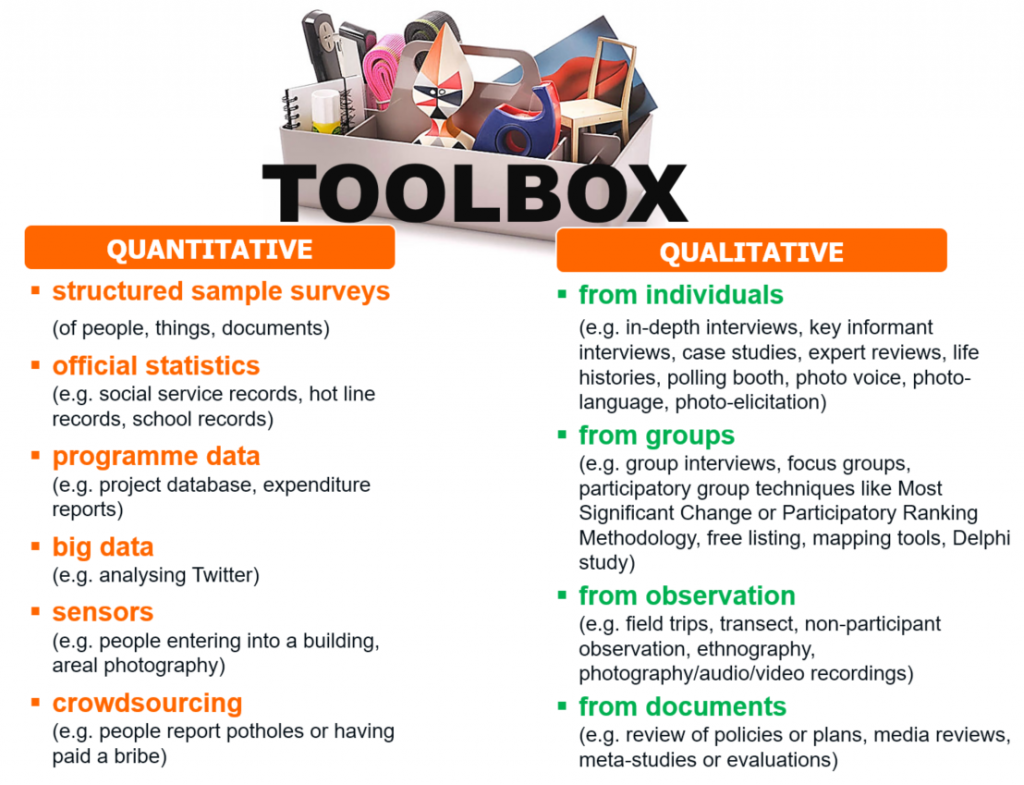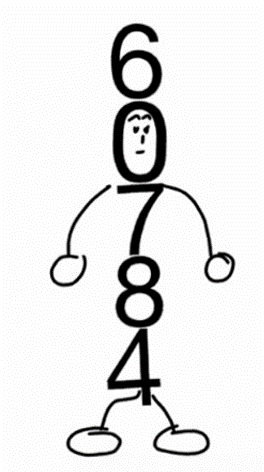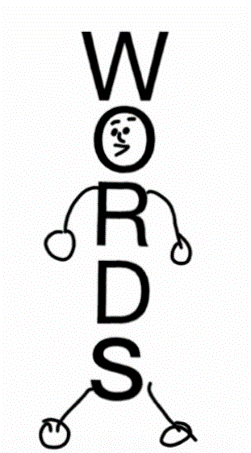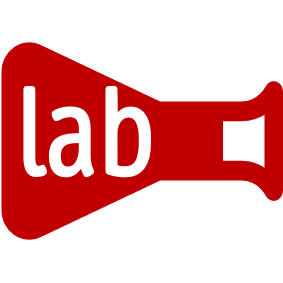Data collection is the basis for Results Based Management, monitoring and evaluations. Good thing that to collect primary data (data that we need to collect first ourselves), we can rely on a rather sophisticated tool box– largely from social sciences – that has been developed over decades.
There are tools for quantitative and qualitative data collection. Here is a list of some of the important tools available to us:

Data collection in numbers and words
Data can be qualitative and quantitative. In other words: it can consist of numbers or text. That’s why our toolbox includes a different set up tools for both categories.
Remember: Quantitative data are numbers. In this case, we can apply mathematical operations in a meaningful manner. Numbers describe something. Think of results from a household survey or the financial data on project expenditure. They are particularly useful in telling us what happens. Qualitative data, on the other hand, consists of text of some sort. Think of ethnographic studies of young widowers or focus group discussions with local politicians from disadvantaged groups. Text is particularly useful in telling us why something happens.
Tools for quantitative data

We have a great variety of tools that collect numbers: structured sample surveys, official statistics, programme data, big data, sensors, and crowdsourcing.
Data collection from sample surveys
Structured sample surveys rely on the magic of sampling. While mostly applied to people in the form of opinion polls, we can equally use them to collect data on things and documents.
Data collection from statistics
Another classic are official statistics of all sorts. We ran dig into and analyse raw statistical data, or combine various sets of data to come up with new insights.
Data collection from programmes
In some cases, programmes and projects already collect some data. This is typically data on inputs, activities, or outputs. We find it in databases, Excel sheets, budgets, Management Information Systems, or budget and expenditure reports.
Data collection from big data
Big data is the (not so) new kid on the block. It refers to data that is too large or complex to be dealt with by traditional data-processing tools. Big data is often the result of our increasingly digital lives: Google search data, tweets on Twitter, mobile phone location data, etc.
Data collection from sensors
Sensors can collect large amounts of data. This can refer e.g. to sensors that track how many people are entering a building, to areal photography and analysis.
Data collection from crowdsourcing
Crowdsourcing is a tool where data collection is ‘outsources’ to a ‘crowd’ of people. For example, we can design an app that allows citizens to report when they come across a pothole in their neighbourhood, or they are obliged to pay a bribe.
Tools for qualitative data

Overall, we can collect qualitative data can from people (individuals and groups), through observation, or from documents.
Data collection from individuals
To collect information from individuals, we have a great variety of established tools available. A classic data collection too are in-depth interviews. These can be be structured, semi-structured or unstructured. Key Informant Interviews are similar and consist of interviewing people who have particularly informed perspectives. Further, expert reviews draw upon peers or experts with relevant experience and expertise. Life histories provide a glimpse into how people experience their lives and the impact of a specific programmes, policy or service. Polling Booth are a tool to collect sensitive information anonymously. Further, photo-language allows participants to choose an existing photograph as a metaphor and then discuss it. And during photo-elicitation, participants select one or two pictures from a set and using them to illustrate their comments about something.
Data collection from groups
We have an equally varied set of tools to collect data from groups. Focus groups are often used to discover issues that are of most concern for a community or group. This works well when little or no information is available. Participatory group techniques aim at a specific goal. It includes e.g. the Most Significant Change and Participatory Ranking Methodology. Free listing identifies criteria by which a certain issue is understood in a particular community. Further, mapping tools involves drawing a map of some kind which is then used to generate discussions. Finally, a Delphi Study solicitates opinions from groups in an iterative process of answering questions in order to gain a consensus.
Data collection from observation
Observations are another rich field for data collection tools. Field trips, for example, involves the physical visit to sites. A transect is includes walking around an area or community and observing people, surroundings and resources, allowing us to gather gathering spatial data. Non-participant observations is based on observing participants without actively participating in a discussion or activity. On the other hand, participant observation identifies attitudes and actions of a community by living within its environment. Ethnographies include participant observation, field notes, interviews, and surveys to represent graphically and in writing the culture of a community. Finally, photography, video, audio recordings document changes that have taken place in the environment or activities of a community over a period of time.
Data collection from documents
Documents can also serve as basis for quantitative data collection. This can take the form of a review of policies or plans. For example, data can be collected and analysed from a sample of community development plans. It can also take the form of media reviews. Documents are also the basis for meta-studies or meta-evaluations. The later are evaluations of evaluation.
This overview is partially based on the always useful website BetterEvaluation. In this case, from the page on Collect and/or Retrieve Data, http://betterevaluation.org/plan/describe/collect_retrieve_data

1 thought on “How to select the right tools for data collection”
Comments are closed.